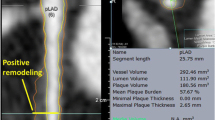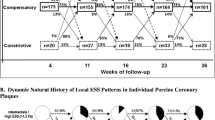Abstract
Coronary arterial remodeling describes changes of vessel size at the site of atherosclerotic lesions. Positive remodeling (expansion) of early lesions maintains lumen size despite plaque accumulation. In contrast, negative remodeling (shrinkage) contributes to luminal stenosis independent of plaque accumulation. Because of these adaptive changes, plaque progression/regression is not closely reflected in luminal size. Histologic studies have demonstrated that the pathophysiologic role of arterial remodeling is more complex than a mere compensatory process. Surprisingly, there is a consistent association between positive arterial remodeling, local inflammatory response, and plaque vulnerability. In vivo tomographic imaging techniques, in particular intravascular ultrasound, and potentially computed tomography and magnetic resonance imaging, allow the observation of remodeling in clinical settings. The integration of basic knowledge about arterial remodeling with clinical observations from in vivo imaging could lead to a better understanding of plaque progression, regression, and vulnerability and may eventually have implications for disease prevention.
Similar content being viewed by others
References and Recommended Reading
Glagov S, Weisenberg E, Zarins CK, et al.: Compensatory enlargement of human atherosclerotic coronary arteries. N Engl J Med 1987, 316: 1371–1375.
Davies MJ, Thomas A: Thrombosis and acute coronary artery lesions in sudden cardiac ischemic death. N Engl J Med 1984, 310: 1137–1140.
Ambrose JA, Tannenbaum MA, Alexopoulos D, et al.: Angiographic progression of coronary artery disease and the development of myocardial infarction. J Am Coll Cardiol 1988, 12: 56–62.
Falk E, Shah PK, Fuster V: Coronary plaque disruption. Circulation 1995, 92: 657–671.
Pasterkamp G, Wensing PJ, Post MJ, et al.: Paradoxical arterial wall shrinkage may contribute to luminal narrowing of human atherosclerotic femoral arteries. Circulation 1995, 91: 1444–1449.
Mintz GS, Kent KM, Pichard AD, et al.: Contribution of inadequate arterial remodeling to the development of focal coronary artery stenoses. Circulation 1997, 95: 1791–1798.
Gibbons GH, Dzau VJ: The emerging concept of vascular remodeling. N Engl J Med 1994, 20: 1431–1438.
Durand E, Mallat Z, Addad F, et al.: Time courses of apoptosis and cell proliferation and their relationship to arterial remodeling and restenosis after angioplasty in an atherosclerotic rabbit model. J Am Coll Cardiol 2002, 39: 1680–1685.
Dollery CM, McEwan JR, Henney AM: Matrix metalloproteinases and cardiovascular disease. Circ Res 1995, 77: 863–868.
Ivan E, Khatri JJ, Johnson C, et al.: Expansive arterial remodeling is associated with increased neointimal macrophage foam cell content. The murine model of macrophage-rich carotid artery lesions. Circulation 2002, 105: 2686–2691.
Schoenhagen P, Vince DG, Ziada K, et al.: Relation of matrix-metalloproteinase 3 found in coronary lesion samples retrieved by directional coronary atherectomy to intravascular ultrasound observations on coronary remodeling. Am J Cardiol 2002, 89: 1354–1359.
Moreno PR, Purushothaman R, Fuster V, O’Connor WN: Intimomedial interface damage and adventitial inflammation is increased beneath disrupted atherosclerosis in the aorta. Implications for plaque vulnerability. Circulation 2002, 105: 2502–2509.
Burke AP, Kolodgie FD, Farb A, et al.: Morphological predictors of arterial remodeling in coronary atherosclerosis. Circulation 2002, 105: 297–303.
Varnava AM, Mills PG, Davies MJ: Relationship between coronary artery remodeling and plaque vulnerability. Circulation 2002, 105: 939–943.
Burke AP, Farb A, Malcom GT, et al.: Coronary risk factors and plaque morphology in men with coronary disease who died suddenly. N Engl J Med 1997, 336: 1276–1282.
Moreno PR, Falk E, Palacios IF, et al.: Macrophage infiltration in acute coronary syndromes: Implications for plaque rupture. Circulation 1994, 90: 775–778.
Shah PK, Falk E, Badimon JJ, et al.: Human monocyte-derived macrophages induce collagen breakdown in fibrous caps of atherosclerotic plaques. Circulation 1995, 92: 1565–1569.
Galis ZS, Sukhova GK, Lark MW, Libby P: Increased expression of matrix metalloproteinases and matrix degrading activity in vulnerable regions of human atherosclerotic plaques. J Clin Invest 1994, 94: 2493–2503.
Libby P: Molecular bases of the acute coronary syndromes. Circulation 1995, 91: 2844–2850.
Burke AP, Kolodgie FD, Farb A, et al.: Healed plaque ruptures and sudden coronary death. Evidence that subclinical rupture has a role in plaque progression. Circulation 2001, 103: 934–940.
Williams H, Johnson JL, Carson KG, Jackson CL: Characteristics of intact and ruptured atherosclerotic plaques in brachiocephalic arteries of apolipoprotein E knockout mice. Arterioscler Thromb Vasc Biol 2002, 22: 788–792.
Small DM, Bond MG, Waugh D, et al.: Physicochemical and histological changes in the arterial wall of nonhuman primates during progression and regression of atherosclerosis. J Clin Invest 1984, 73: 1590–1605.
Aikawa M, Rabkin E, Okada Y, et al.: Lipid lowering by diet reduces matrix metalloproteinase activity and increases collagen content of rabbit atheroma. Circulation 1998, 97: 2433–2444.
Pasterkamp G, Schoneveld AH, van der Wal AC, et al.: Relation of arterial geometry to luminal narrowing and histologic markers for plaque vulnerability: the remodeling paradox. J Am Coll Cardiol 1998, 32: 655–662.
Schoenhagen P, Ziada KM, Kapadia SR, et al.: Extent and direction of arterial remodeling in stable and unstable coronary syndromes. Circulation 2000, 101: 598–603.
Smits PC, Pasterkamp G, de Jaegere PP, et al.: Angioscopic complex lesions are predominantly compensatory enlarged: an angioscopic and intracoronary ultrasound study. Cardiovasc Res 1999, 41: 458–464.
Yamagishi M, Terashima M, Awano K, et al.: Morphology of vulnerable coronary plaque: insights from follow-up of patients examined by intravascular ultrasound before and acute coronary syndrome. J Am Coll Cardiol 2000, 35: 106–111.
Mehran R, Dangas G, Mintz GS, et al.: Atherosclerotic plaque burden and CK-MB enzyme elevation after coronary interventions. Circulation 2000, 101: 604–610.
Wexberg P, Gyoengyoesi M, Sperker W, et al.: Pre-existing arterial remodeling is associated with in-hospital and late adverse cardiac events after coronary interventions in patients with stable angina pectoris. J Am Coll Cardiol 2000, 36: 1860–1869.
Dangas G, Mintz GS, Mehran R, et al.: Preintervention arterial remodeling as an independent predictor of target-lesion revascularization after nonstent coronary intervention. Circulation 1999, 99: 3149–3154.
Okura H, Hayase M, Shimodozono S, et al.: Impact of preinterventional arterial remodeling on subsequent vessel behavior after balloon angioplasty: a serial intravascular ultrasound study. J Am Coll Cardiol 2001, 38: 2001–2005.
Dangas G, Mintz GS, Mehran R, et al.: Stent implantation neutralizes the impact of preintervention arterial remodeling on subsequent target lesion revascularization. Am J Cardiol 2000, 86: 452–455.
Schoenhagen P, Magyar WA, Kapadia SR, et al.: Negative remodeling frequently occurs in mildly stenotic native coronary lesions and is unrelated to plaque size. J Am Coll Cardiol 2002, 39(suppl A):246A.
Brown G, Albers JJ, Fisher LD, et al.: Regression of coronary artery disease as a result of intensive lipid-lowering therapy in men with high levels of apolipoprotein B. N Engl J Med 1990, 323: 1289–1298.
Tuzcu EM, Kapadia SR, Tutar E, et al.: High prevalence of coronary atherosclerosis in asymptomatic teenagers and young adults: evidence from intravascular ultrasound. Circulation 2001, 103: 2705–2710.
Strong JP, Malcom GT, McMahan CA, et al.: Prevalence and extent of atherosclerosis in adolescents and young adults: implications for prevention from pathobiological determinants of atherosclerosis in youth study. JAMA 1999, 281: 727–735.
Rioufol G, Finet G, Ginon I, et al.: Multiple atherosclerotic plaque rupture in acute coronary syndrome. A three-vessel intravascular ultrasound study. Circulation 2002, 106: 804–808.
Goldstein JA, Demetriou D, Grines CL, et al.: Multiple complex coronary plaques in patients with acute myocardial infarction. N Engl J Med 2000, 343: 915–922.
Schoenhagen P, Tuzcu EM, Ellis SG: Plaque vulnerability, plaque rupture, and acute coronary syndromes. (Multi)-focal manifestation of a systemic disease process. Circulation 2002, 106: 760–762.
Halliburton SS, Stillman AE, White RD: Non-invasive quantification of coronary artery calcification: a potential tool for the assessment of coronary artery disease in patients with chronic renal failure. Cleveland Clin J Med 2002, 69(suppl 3): S6-S11.
Secci A, Wong N, Tang W, et al.: Electron beam computed tomographic coronary calcium as a predictor of coronary events. Circulation 1997, 96: 1122–1129.
Schmermund A, Erbel R: Unstable coronary plaque and its relation to coronary calcium. Circulation 2001, 104: 1682–1687.
Achenbach S, Ropers D, Pohle K, et al.: Influence of lipid-lowering therapy on the progression of corooary artery calcification. Circulation 2002, 106: 1077–1082.
O’Rourke RA, Brundage BH, Froelicher VF, et al.: American College of Cardiology/American Heart Association expert consensus document on electron-beam computed tomography for the diagnosis and prognosis of coronary artery disease. Circulation 2000, 102: 126–140.
Takagi T, Yoshida K, Akasaka T, et al.: Intravascular ultrasound analysis of reduction in progression of coronary narrowing by treatment with pravastatin. Am J Cardiol 1997, 79: 1673–1767.
Schartl M, Bocksch W, Koschyk DH, et al.: Use of intravascular ultrasound to compare effects of different strategies of lipid-lowering therapy on plaque volume and composition in patients with coronary artery disease. Circulation 2001, 104: 387–392.
Nissen SE: Rationale for a postintervention continuum of care: insights from intravascular ultrasound. Am J Cardiol 2000, 86: 12H-17H.
Schroeder S, Kopp AF, Baumbach A, et al.: Noninvasive detection and evaluation of atherosclerotic coronary plaques with multislice computed tomography. J Am Coll Cardiol 2001, 37: 1430–1435.
Fayad ZA, Fuster V: Clinical imaging of the high-risk or vulnerable atherosclerotic plaque. Circ Res 2001, 89: 305–316.
Corti R, Fayad ZA, Fuster V, et al.: Effects of lipid-lowering by simvastatin on human atherosclerotic lesions: a longitudinal study by high-resolution, noninvasive magnetic resonance imaging. Circulation 2001, 104: 249–252.
Author information
Authors and Affiliations
Rights and permissions
About this article
Cite this article
Schoenhagen, P., Nissen, S.E. & Tuzcu, E.M. Coronary arterial remodeling: From bench to bedside. Curr Atheroscler Rep 5, 150–154 (2003). https://doi.org/10.1007/s11883-003-0088-9
Issue Date:
DOI: https://doi.org/10.1007/s11883-003-0088-9




